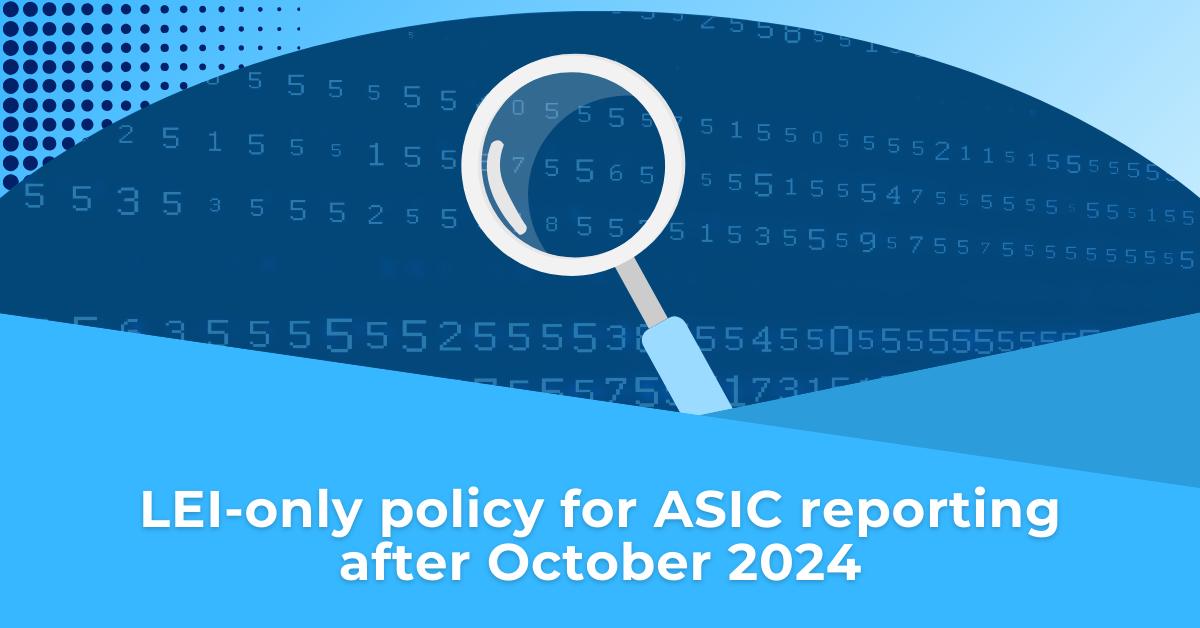The ASIC Reporting Rules now provide that Legal Entity Identifiers (LEIs) are the only allowable entity identifier for all eligible relevant entities under the ASIC reporting regime.
All LEIs used as entity identifiers for the reporting entity, counterparty 1 (and the central counterparty) will need to be duly renewed and remain valid at all times.
A renewed LEI is not required for the non-reporting entity, counterparty 2 in the transaction. However, if it does not have an LEI (including a lapsed LEI), it will need to have an alternate identifier which may be:
- a designated business identifier such as an ABN, AVID (issued by AVOX Limited) or Business Identifier Code (BIC) (issued by SWIFT); or a
- client code (which is in the format and structure of the Reporting Entity’s or execution agent’s LEI).
To be able to use the above alternate identifiers, the following both need to have been satisfied:
- Within 2 business days after the requirement to report a transaction arose, you have applied for an LEI; and
- You will need to use all reasonable endeavours to report the LEI, as soon as reasonably practical after it has become available.
| Types of Counterparties | Types of Identifiers | Rules prior to 21 October 2024 | Current Rules |
|---|---|---|---|
| Individuals | Client code | client code (assigned by the reporting counterparty) | client code (=reporting counterparty’s LEI + assigned extra characters as specified in the CDE Guidelines) |
| Non-individuals | LEI | ✓ | ✓ |
| AVID | ✓ | 🗙 | |
| BIC | ✓ | 🗙 |
What’s the impact on you?
We recommend you implement an LEI-only policy for all your non-individual clients given the changes that commenced on 21 October 2024.
What action do you need to take?
Firms should have already implemented changes to your reporting for the clients that are still using AVID codes. This means transitioning to using LEIs, updating any internal systems required, communicating this change with your clients and requesting them to provide you with the necessary data so that they are reported correctly now that the new rules have gone live.
Practical Steps for identifying impacted clients, re-reporting and breach reporting:
- Review identifiers being used for all counterparties that have transactions subject to the ASIC Reporting Rules.
- Where there are non-individual clients, identify if they are being reported using AVID or BIC codes.
- Ensure those impacted counterparties obtain an LEI if they do not already have one. LEIs need to be reported as soon as reasonably practical after they are available.
- Consider if a breach needs to be reported to ASIC for instances where:
- AVID/BIC has been used after 21 October 2024. This includes consideration of whether, whilst an AVID or BIC has been used, there was an application for an LEI put in place and within the 2 business day requirement (as mentioned above); and
- LEIs that have been applied for and received, have not been reported at all or reported on time.
- Review whether re-reporting for those trades should be conducted once the LEI is obtained by the counterparty – to do this, a reporting entity would update the ‘Counterparty 2’ identifier via a change report (where Action Type = MODI and Event Type = TRAD).
Internal Framework Steps:
- For clients that have not been using LEIs or don’t have LEIs, communicate the change with them and request them to provide you with the necessary data so that they are reported correctly now that the new rules have gone live.
- Update any internal systems required so as to group identifier types permissible for your individual and non-individual clients moving forward.
- Ensure policies and processes are updated on client identification regarding their identifier codes, re-reporting transactions for impacted clients and breach reporting.
Why has ASIC implemented this change?
An aim of ASIC’s rule rewrites was to align as closely as practical with the rules of other jurisdictions (such as CFTC and EMIR).
LEIs are considered a crucial data element for the standardisation of identifying relevant entities in derivative transactions. They are an essential part of the global effort to achieve consistency to allow for global data aggregation.
The previous ASIC Reporting Rules (i.e. prior to the changes that occurred on 21 October 2024) provided that, for other than an individual, an LEI is required to be reported but, if not available, an AVID or a BIC is a valid entity identifier (see Rule 2.1.1).
If you have any questions, please do not hesitate to contact us.




